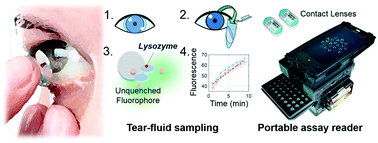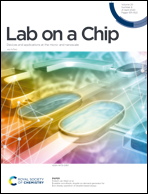Contact lens-based lysozyme detection in tear using a mobile sensor†
Abstract
We report a method for sensing analytes in tear-fluid using commercial contact lenses (CLs) as sample collectors for subsequent analysis with a cost-effective and field-portable reader. In this study we quantify lysozyme, the most prevalent protein in tear fluid, non-specifically bound to CLs worn by human participants. Our mobile reader uses time-lapse imaging to capture an increasing fluorescent signal in a standard well-plate, the rate-of-change of which is used to indirectly infer lysozyme concentration through the use of a standard curve. We empirically determined the best-suited CL material for our sampling procedure and assay, and subsequently monitored the lysozyme levels of nine healthy human participants over a two-week period. Of these participants who were regular CL wearers (6 out of 9), we observed an increase in lysozyme levels from 6.89 ± 2.02 μg mL−1 to 10.72 ± 3.22 μg mL−1 (mean ± SD) when inducing an instance of digital eye-strain by asking them to play a game on their mobile-phones during the CL wear-duration. We also observed a lower mean lysozyme concentration (2.43 ± 1.66 μg mL−1) in a patient cohort with dry eye disease (DED) as compared to the average monitoring level of healthy (no DED) human participants (6.89 ± 2.02 μg mL−1). Taken together, this study demonstrates tear-fluid analysis with simple and non-invasive sampling steps along with a rapid, easy-to-use, and cost-effective measurement system, ultimately indicating physiological differences in human participants. We believe this method could be used in future tear-fluid studies, even supporting multiplexed detection of a panel of tear biomarkers toward improved diagnostics and prognostics as well as personalized mobile-health applications.

- This article is part of the themed collection: Wearable and Implantable Sensors


 Please wait while we load your content...
Please wait while we load your content...